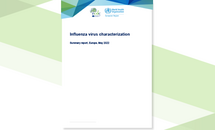Influenza virus characterisation, summary Europe, April 2020
ECDC’s influenza virus characterisation reports are published periodically and give an overview of circulating influenza viruses. They provide details on the current vaccine strains, summarise the development of the viruses since the last report, and closely follow the main developments for the ongoing influenza season. Virus characterisation reports are primarily intended for influenza virologists and epidemiologists.
Executive Summary
This is the sixth report for the 2019–20 influenza season. As of week 18/2020,162 345 influenza detections across the WHO European Region had been reported; 73% type A viruses, with A(H1N1)pdm09 prevailing over A(H3N2), and 27% type B viruses, with 4 418 (98%) of 4 505 ascribed to a lineage being B/Victoria.
Since the March 2020 characterisation report1, no shipments of influenza-positive specimens from EU/EEA countries have been received at the London WHO CC, the Francis Crick Worldwide Influenza Centre (WIC). In total, 1 076 virus specimens, with collection dates after 31 August 2019, have been received.
Since the last report, no A(H1N1)pdm09 test viruses from EU/EEA countries were characterised antigenically but previous analyses have shown the great majority of test viruses to be well recognised by antisera raised against the 2019–20 vaccine virus, A/Brisbane/02/2018. Those viruses showing poor reactivity generally carried amino acid substitutions (notably N156K) in the HA1 150-loop region. The 267 EU/EEA test viruses with collection dates from week 40/2019 genetically characterised at the WIC have fallenwithin subclades of clade 6B.1A: 237 6B.1A5A, 20 6B.1A5B, 1 6B.1A6 and 9 6B.1A7.
Since the last report, no A(H3N2) viruses have been characterised antigenically, but previous analyses have shown clade3C.3a-specific recognition by antisera raised againstegg-propagated A/Kansas/14/2017, the current vaccine virus. Globally there have been approximately equal proportions of clade 3C.3a and subgroups 3C.2a1b+T131K and 3C.2a1b+T135K viruses detected. However, based on sequences available in GISAID from viruses detected since 1 February 2020, subgroups 3c.2a1b+T135KA/B are prevalent in the USA while those of clade 3C.3a and subgroup 3C.2a1b+T131K dominate in Europe. In total, 351 viruses from EU/EEA countries have been characterised genetically at the WIC: 183 clade 3C.3a, 111 3C.2a1b+T131K, 42 3C.2a1b+T135K-A and 15 3C.2a1b+T135K-B.
No B/Victoria-lineage viruses were characterised antigenically in this reporting period. Viruses detected in EU/EEA countries during February and March 2020, based on sequences available in GISAID, have all fallen in the 1A(Δ3)B subgroup. Viruses in this subgroup have been antigenically similar to B/Washington/02/2019, the vaccine virus for the 2020–2021 northern hemisphere influenza season. In total, 209 EU/EEA viruses have been characterised genetically at the WIC: 196 subgroup 1A(Δ3)B and 13 subclade 1A(Δ2).
No B/Yamagata-lineage viruses were characterised antigenically in this reporting period. All seven EU/EEA viruses characterised genetically at the WIC since week 40/2019, as for all recently circulating B/Yamagata-lineage viruses, belong to genetic clade 3 and contain at least two HA amino acid substitutions (HA1 L172Q and M251V) compared to B/Phuket/3073/2013, the antigenic effects of which have been minimal as assessed in earlier reports.
Download

Read more on the ECDC website
Surveillance for seasonal influenza
Latest surveillance reports and disease data on seasonal influenza; Flu News Europe, Influenza virus characterisation reports, ECDC Surveillance Atlas, Annual Epidemiological Reports.
Microbiology
Microbiology and laboratory reports; External quality assessments, Influenza virus characterisations.




